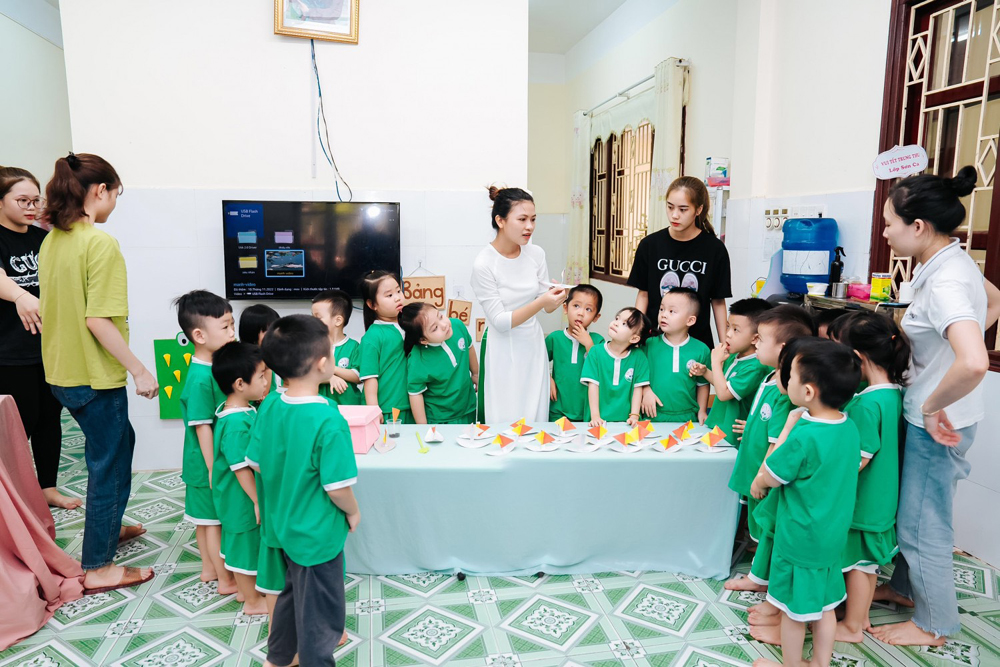This proposal is part of a draft decree on universal preschool education for children aged 3 to 5, announced by the Ministry of Education and Training on 5/8, encompassing four main policy groups.
Within the policy group for teachers, the Ministry also proposed a monthly support of 41 USD for public preschool staff (including contract and probationary employees) in extremely disadvantaged areas who work on universalization tasks for at least 15 days per month.
As of the middle of the last school year, the country lacked about 120,000 teachers, of which 48,000 were at the preschool level. The base salary for this group currently ranges from 210 to 640 USD per month (base salary multiplied by a coefficient), plus a professional allowance of 35-70% and other benefits, depending on the position.
The second policy group prioritizes the development of preschool education in disadvantaged, extremely disadvantaged, ethnic minority, mountainous, border, coastal, island areas, and areas with industrial parks and export processing zones. The goal is that by 2030, these areas will have sufficient facilities, ensuring one classroom per kindergarten class, along with adequate function rooms, libraries, indoor and outdoor toys, and teaching equipment.
Specifically, preschools in these areas with semi-boarding 3- to 5-year-old children will receive support for purchasing paper, comic books, coloring books, pencils, and other learning materials; blankets, mosquito nets, and personal items for children. The allocation is 58 USD per semi-boarding child per year.
This is accompanied by support for electricity and water for learning and living, with a quota of 5KW of electricity and 1 m3 of water per child per month. In areas without electricity and water, schools can use the funds to purchase lighting equipment and clean water.
In addition, schools receive support for lunchtime childcare. Each group of children (for example, 25 children aged 3-4, 30 children aged 4-5, or 35 children aged 5-6) with at least 8 semi-boarding children receives 30 USD per month. If the number of children exceeds 50% of the above figures, that group receives an additional support allowance.
The minimum support for lunch preparation is 167 USD per month for groups of over 45 children. If the number of children exceeds this by 20 or more, the school receives an additional allowance, up to a maximum of 5 times.
 |
Class time at a preschool in Hai Duong in 2023. Photo: Le Tan |
Class time at a preschool in Hai Duong in 2023. Photo: Le Tan
The third policy group focuses on children. Children aged 3 to 5 whose parents or legal guardians work in industrial parks receive 6 USD per month, regardless of whether they attend private or public schools.
Additionally, lunch support is increased from 7 USD to 15 USD per month for children in communes, villages, and coastal areas with particularly difficult socio-economic conditions. Children without caregivers; from poor or near-poor families; children of martyrs, People's Armed Forces Heroes, wounded soldiers, or disabled children also fall under this category.
For policy groups two and three, schools receive support for no more than 9 months per academic year.
The final policy group concerns investment in developing the network of schools, classrooms, teaching equipment, and staff development. The goal is that by 2030, all preschools will have 100% permanent classrooms; sufficient teachers; and guaranteed benefits and policies for managers, teachers, and staff implementing universal preschool education.
Universal education is the process of organizing educational activities so that all citizens of school age can study and reach a certain level of education, as prescribed by law.
Currently, universal preschool applies to 5-year-old children. Since 2017, all localities have achieved and maintained this, enrolling over 99% of 5-year-old children in school.
In April, the Ministry proposed spending 3.9 billion USD over 10 years to expand this to children aged 3 to 5, including tuition support for children of factory workers and a 12-month base salary allowance to attract teachers.
Annually, over 5.1 million preschool children are nurtured, cared for, and educated at approximately 15,000 schools and 17,000 independent preschool education facilities. The number of children aged 3 to 5 is about 4.5 million. The school attendance rate for this group is 93.6%.
Binh Minh












